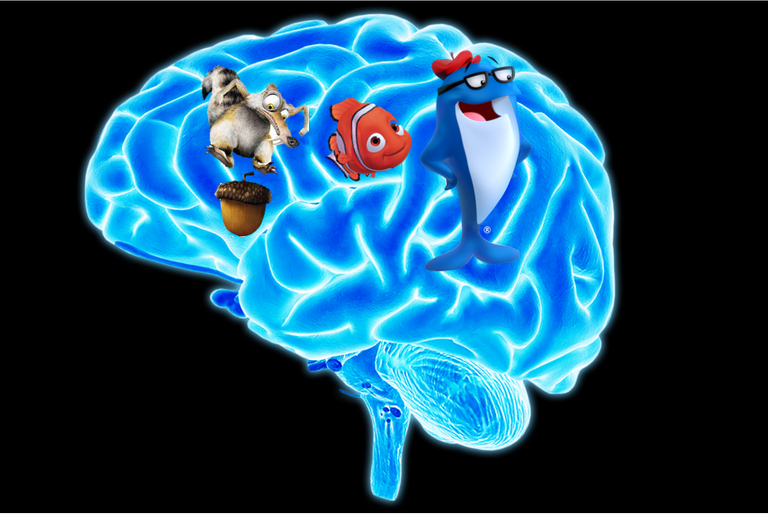
Your brain is over 60% fat. This “fat” in the brain is not the same as the fat cells that makes your stomach pudgy. The fat that accumulates around your waste is the fat that your body uses to store energy. The fat in your brain is used to protect and help with the functioning of your neurons and is in the form of lipids. Lipids are basically fatty acids.
The three Omega-3’s ALA, DHA and EPA
As with anything, the quality of the ingredients and foundation end up playing a critical role in the quality and functioning of the end product. So not all fats are equal and not all fats will result in the best cells for your brain. The best kind of fat for your brain is Omega-3. There are three types of Omega-3 fats, ALA, DHA and EPA. (ALA:alpha-linolenic acid, DHA:docosahexaenoic acid, and EPA:eicosapentaenoic acid). DHA and EPA are found in fish and fish oils. Walnuts and other nuts and seeds as well as algae contain ALA. Your body then converts the ALA into DHA and EPA. But this conversion that your body does is not very efficient, so fish remains the best direct source for EPA and DHA Omega-3.

Excuse me waiter, is there mercury in that fish?
A brief word on fish size and mercury. While fish such as tuna and salmon and many other fatty, large fish are great sources of DHA and EPA Omega-3 fats, it is better stick to smaller fish for frequent consumption. The larger the fish the larger the mercury or methylmercury content in the fish. Mercury is a heavy metal which is toxic to the body and high doses can lead to all sorts of serious maladies. Mercury is a naturally occurring element and normal for small traces in the food chain, however, human activities have greatly increased the amount of mercury in our food chain and that poses additional challenges for healthy eating. Mercury is released as a pollutant in many industrial processes including gold mining, coal refinement, waste incineration and even in the exhaust from cars. This gets released in the atmosphere and then brought down to earth in the rain where it enters into the ecosystem via water and plants, including algae. The fish that eat the algae will consume small traces of mercury. Bigger fish eat the smaller fish. The end result is, the bigger the fish, the higher the concentration levels of mercury contamination.
What if the music group ZZ Top were called Omega Omega Top?
Ok, so now back to Omega 3 and related Omega fats. In addition to Omega-3 there are also other Omega fats which are considered necessary and good for you, notably Omega-6 and Omega-9.
First off, have you ever wondered why they are called “Omega” fats? Omega is the last letter in the Greek alphabet. The chemistry is a bit beyond me so I have tried to express it in a way that I can understand at the moment. A fatty acid chemical compound has two ends, like a piece of string. One end is considered the beginning of the molecular and atomic chain that make up the fatty acid and the other side is the end or tail of the chain. Each end has different acidic properties. The Omega fats have a type of bond that occurs close to the tail and is counted by starting at the tail of the chain. Hence the use of Omega to describe the starting point for counting the atomic bond position in a fatty acid. In an Omega 3 fat, this bond occurs at the third carbon atom from the tail of the chain. In an Omega 6 fat, the special bond occurs at the sixth carbon atom from the end. I think you can guess where this bond shows up in an Omega 9 fat. The special bond is a double bond, two carbon atoms as opposed to a single bond between the carbon atoms.
Unsaturated and Saturated Fats
When speaking of fats, in addition to the “omega” fats, we also frequently see the terms saturated, monounsaturated, polyunsaturated and transfat. Transfat is also often referred to as hydrogenated fat. Let’s break these labels of saturated and unsaturated down a bit and then we will move back to the discussion on Omega fats and how they relate to the mono/poly/saturated and trans fat.
Foods usually contain a mixture of fats with a higher percentage of one type over the other. The unsaturated fats, both mono and poly are considered as fats which may lower your overall cholesterol, more so the bad cholesterol, and are generally liquid at room temperature. However, be careful with the “liquid at room temperature rule” and do your fact checking if you are unsure. For example, coconut oil is predominantly comprised of saturated fat and sometimes may also be liquid at room temperature particularly in summer months. Saturated fats are usually solid at room temperature and are considered to cause total cholesterol levels to rise. The last type of fat, transfat, does occur in small amounts naturally in the food chain however industrialization has resulted in much greater quantities. It is usually an industrial produced fat which is fabricated by hydrogenating mono or polyunsaturated fats and turning them into saturated fats. This is usually done in industrial food processes to increase conservation time of food as well as flavor and texture.
What do the terms saturated and unsaturated mean? In chemistry, saturated refers to when a chemical compound has a carbon atom chain that is linked by single bonds. Unsaturated chemical compounds contain double, or even triple, bonds between the carbon atoms. A monounsaturated contains only one of these types of bonds whereas a polyunsaturated fat contains many unsaturated bonds. Industrially produced hydrogenated fats (transfats) create carbon chain bonds that your body can not breakdown and hence these fats are considered dangerous and unhealthy as they tend to build up over time.
What kind of fat is Omega-3 again?
Omega-3 and Omega-6 are both types of polyunsaturated fats. Omega-9 is a monounsaturated fat. The body does not naturally produce Omega-3 or Omega-6 fats, yet the body does need them in some small quantities. Hence the only way to get the Omega-3 and Omega-6 is to consume them. Your body does produce Omega-9 naturally hence there has not been a lot of fuss made about consuming Omega-9 to supplement your body’s functioning.
The punchline
The point of all this is that eating healthy fatty acids in small quantities, Omega-3 and Omega-6, will help keep your brain and your body healthy. Your brain relies extensively on Omega-3 fats to keep the brain cells healthy. Your body does not naturally produce these fats. Your body only needs small amounts of them. Western diets tend to have a higher ratio of Omega 6 than Omega 3 and too much Omega 6 can lead to problems which include inflammation, blood clotting and constriction of blood vessels. There is an ongoing debate on the right ratio of Omega 3 to Omega 6 to consume. While there is not agreement on this ratio, whether that should be should be 1:1 or something else, there is agreement that most people would benefit by increasing the Omega 3 levels in their diet. However, increase does not mean overdoing it. If you have too much or the wrong fat ratios in your body it can provoke health issues and long-term damage to your body.
Trans and hydrogenated fats should systematically be avoided as your body simply lacks the capability to break them down and their build up over time may cause significant health problems. Transfats are usually found in cakes, pies, cookies, biscuits, margarine, crackers, doughnuts, and fried fast foods. The good news is that government agencies have stepped in and have passed rules to lower the amount of transfat in the food supply. In June of 2015 the US Food and Drug Administration (FDA) ruled that no quantity of transfat could be considered safe and gave food companies a three-year grace period to stop making foods using transfats and specifically hydrogenated oils. So, by June of 2018 we should stop seeing transfat being artificially introduced into food products in the US. Canada recognizes the dangers of transfats but have not yet managed to pass any mandatory restrictions into law. Meanwhile there has been success across the Atlantic and many European countries already have limits and restrictions basically banning transfats, including Switzerland, Denmark, Austria, Hungary, Iceland and Norway.
Sources and Dietary Reference Intakes of Selected Fatty Acids
| Type | Fatty Acid | Major Food Sources | US Dietary Reference Intake (DRI) | Usual Daily Intake |
|---|---|---|---|---|
| Omega-3 | (ALA) Alpha-linolenic acid (18:3, n-3) | Flax, chia and hemp seeds, walnuts, canola and soybean oils | Adequate Intake (AI): 1.1 to 1.6 g, 0.6% to 1.2% of energy intake | 1.4 to 1.8 g |
| Omega-3 | (EPA) Eicosapentaenoic acid (20:5, n-3) | Fish and seafood | No DRI established | 30 to 40 mg |
| Omega-3 | (DHA) Docosahexaenoic acid (22:6, n-3) | Fish and seafood | No DRI established | 60 to 80 mg |
| Omega-6 | (LA) Linoleic acid (18:2, n-6) | Soybean and corn oils, shortening | AI: 12 to 17 g, 5% to 10% of energy intake | 13 to 18 g |
| Omega-6 | (ARA) Arachidonic acid (20:4, n-6) | Meat, poultry, eggs | No DRI established | 120 to 180 mg |
| Omega-7 | Palmitoleic acid (16:1, n-7) | Macadamia nuts, blue-green algae | No DRI established | 1.2 g |
| Omega-9 | Oleic acid (18:1, n-9) | Olive and canola oils, avocado, beef tallow, lard | No DRI established | 27 g |
— Source of the table is taken from: Vannice G, Rasmussen H. Position of the Academy of Nutrition and Dietetics: dietary fatty acids for healthy adults. J Acad Nutr Diet. 2014;114(1):136-153
In the preceding table, the numbers after the acid name are the lipid numbers. Lipid numbers have the form C:D, where C is the number of carbon atoms in the fatty acid and D is the number of double bonds in the fatty acid. The n- is the position in the chain as to where the first double bond occurs from the Omega end of the chain.
If you are like me, you rarely walk around with measuring tools to actually measure the number of ounces or grams you are eating.
This is not precise, but can be a practical measurement guide
- Nuts: 1.4 to 1.8g of nuts would be one small handful
- Oily fish: A good portion, 30 to 80 mg, of oily fish like salmon and tuna the recommendation is about the size of the palm of your hand. Although no daily recommended intake is mentioned in the above table, 1 or 2 times a week is the typical recommendation and not daily.
- Red meat: 120 to 180 mg of red meat would be about the size of your hand excluding your fingers and about as thick as a deck of cards
- Olive oil, canola oil: 27g of olive oil is about 1 and half tablespoons.
If you enjoyed reading this post or found it useful, please recommend and share it to help others find it! You may also enjoy other reports published by The Hutch Report such as the latest full report on Virtual Reality including overviews on 65 companies, major players and startups to watch. www.thehutchreport.com
References and Main Sources for researching this article:
http://articles.mercola.com/sites/articles/archive/2009/01/22/fascinating-facts-you-never-knew-about-the-human-brain.aspx
https://www.quora.com/If-the-brain-is-60-fat-is-it-affected-when-body-fat-becomes-very-low-due-to-starvation-or-dieting
https://www.ncbi.nlm.nih.gov/pubmed/20329590
http://www.webmd.com/diet/guide/your-omega-3-family-shopping-list#1
https://www.ncbi.nlm.nih.gov/pmc/articles/PMC5336545/
https://www.ces.ncsu.edu/hhb/hhb6-1.htm
http://www.umm.edu/health/medical/altmed/supplement/omega6-fatty-acids
http://articles.mercola.com/sites/articles/archive/2011/11/11/everything-you-need-to-know-about-fatty-acids.aspx
https://draxe.com/omega-9-benefits/
http://www.todaysdietitian.com/newarchives/040114p20.shtml
https://en.wikipedia.org/wiki/Omega-3_fatty_acid
https://en.wikipedia.org/wiki/Saturated_and_unsaturated_compounds
http://www.webmd.com/food-recipes/features/fast-food-french-fries-which-are-healthiest#1
https://health.clevelandclinic.org/2015/06/fda-decision-aims-to-eliminate-trans-fat-from-your-food/
https://www.fda.gov/ForConsumers/ConsumerUpdates/ucm372915.htm
Portion sizes
http://www.dailymail.co.uk/health/article-3331095/Handy-guide-portion-sizes-Never-know-food-Use-formula-figure-right-eat.html
Mercury in Fish:
http://www.nwf.org/Wildlife/Threats-to-Wildlife/Pollutants/Mercury-and-Air-Toxics.aspx

@originalworks
To call @OriginalWorks, simply reply to any post with @originalworks or !originalworks in your message!
Thank you @minnowpond
@resteem1